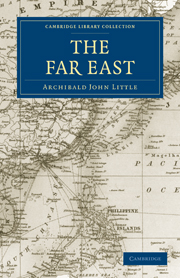Book contents
- Frontmatter
- PREFACE
- EDITORIAL NOTE
- Contents
- LIST OF MAPS AND ILLUSTRATIONS
- CHAPTER I DEFINITION
- CHAPTER II THE CENTRAL KINGDOM: CHINA
- CHAPTER III THE NORTHERN BASIN. THE YELLOW RIVER
- CHAPTER IV THE MIDDLE BASIN: PART I. THE YANGTSE RIVER
- CHAPTER V THE MIDDLE BASIN: PART II. THE PROVINCE OF SZECHUAN
- CHAPTER VI THE MIDDLE BASIN: PART III. THE CHENGTU PLATEAU
- CHAPTER VII THE MIDDLE BASIN: PART IV. THE LOWER YANGTSE PROVINCES
- CHAPTER VIII THE INTERMEDIATE PROVINCES
- CHAPTER IX THE SOUTHERN BASIN. YUNNAN TO CANTON
- CHAPTER X THE DEPENDENCIES: PART I. MANCHURIA
- CHAPTER XI THE DEPENDENCIES: PART II. MONGOLIA
- CHAPTER XII THE DEPENDENCIES: PART III. TURKESTAN
- CHAPTER XIII THE DEPENDENCIES: PART IV. TIBET
- CHAPTER XIV WHILOM DEPENDENCIES: PART I. INDO-CHINA
- CHAPTER XV WHILOM DEPENDENCIES: PART II. COREA
- CHAPTER XVI THE BUFFER KINGDOM: SIAM
- CHAPTER XVII THE ISLAND EMPIRE: JAPAN
- INDEX
- Plate section
CHAPTER XIV - WHILOM DEPENDENCIES: PART I. INDO-CHINA
Published online by Cambridge University Press: 05 October 2010
- Frontmatter
- PREFACE
- EDITORIAL NOTE
- Contents
- LIST OF MAPS AND ILLUSTRATIONS
- CHAPTER I DEFINITION
- CHAPTER II THE CENTRAL KINGDOM: CHINA
- CHAPTER III THE NORTHERN BASIN. THE YELLOW RIVER
- CHAPTER IV THE MIDDLE BASIN: PART I. THE YANGTSE RIVER
- CHAPTER V THE MIDDLE BASIN: PART II. THE PROVINCE OF SZECHUAN
- CHAPTER VI THE MIDDLE BASIN: PART III. THE CHENGTU PLATEAU
- CHAPTER VII THE MIDDLE BASIN: PART IV. THE LOWER YANGTSE PROVINCES
- CHAPTER VIII THE INTERMEDIATE PROVINCES
- CHAPTER IX THE SOUTHERN BASIN. YUNNAN TO CANTON
- CHAPTER X THE DEPENDENCIES: PART I. MANCHURIA
- CHAPTER XI THE DEPENDENCIES: PART II. MONGOLIA
- CHAPTER XII THE DEPENDENCIES: PART III. TURKESTAN
- CHAPTER XIII THE DEPENDENCIES: PART IV. TIBET
- CHAPTER XIV WHILOM DEPENDENCIES: PART I. INDO-CHINA
- CHAPTER XV WHILOM DEPENDENCIES: PART II. COREA
- CHAPTER XVI THE BUFFER KINGDOM: SIAM
- CHAPTER XVII THE ISLAND EMPIRE: JAPAN
- INDEX
- Plate section
Summary
While the empire of China, or rather the Central Flowery Land, as the Chinese designate the eighteen provinces of China proper, is surrounded on the north and west by the dependencies surveyed in the preceding chapters, and on the east by the sea, the southern frontier is coterminous with Indo-China. Tongking in ancient times formed, with the present ‘Kwang’ provinces—Kwangsi and Canton, the kingdom of Yueh, which was conquered under the martial Han dynasty in the second century b.c. The hold of the Chinese was intermittent, however, from the time of the break-up of the Han until comparatively recent times, when the country was definitely reconquered under the reign of Yunglo, the third emperor of the Ming dynasty, A.D. 1403—25; but subsequent emperors contented themselves with the acknowledgement of Chinese suzerainty and the sending of an annual tribute. Meanwhile, the Annamese had adopted Chinese civilization and had organized the government on the Chinese model, with officials selected by competitive examination in the Chinese classics, Confucianism having long previously been adopted as the national cult. In the eighteenth century Roman Catholic missions were established in the country, quarrels ensued, resulting ultimately in annexation, first of Lower Cochin-China in 1859—63, and lastly of Tongking, after an inglorious war with China, in 1884; and thus the present French empire of Indo-China became an established fact.
- Type
- Chapter
- Information
- The Far East , pp. 219 - 242Publisher: Cambridge University PressPrint publication year: 2010First published in: 1905



